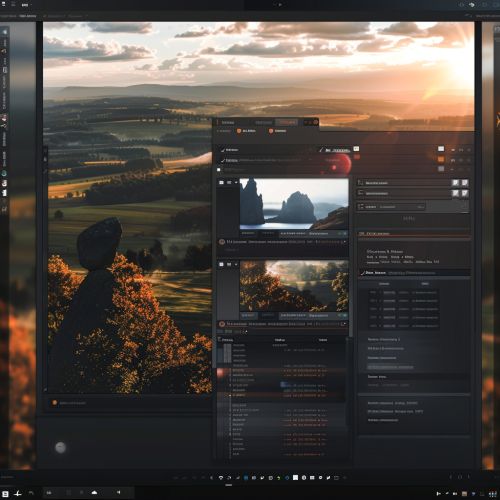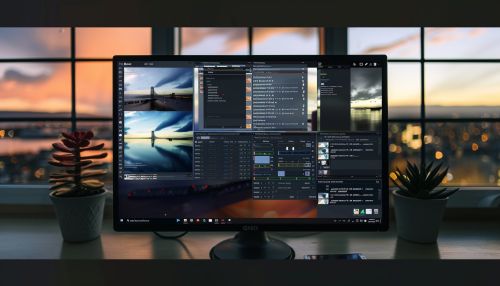GNOME Terminal
Overview
GNOME Terminal is a terminal emulator for the GNOME desktop environment, which is a part of the GNU Project. It allows users to access the command line interface (CLI) of their operating system, providing a text-based interface for interacting with the system. GNOME Terminal is an essential tool for developers, system administrators, and power users who require a robust and flexible terminal emulator.
Features
GNOME Terminal offers a wide range of features that enhance the user experience and provide advanced functionality. Some of the key features include:
Tabbed Interface
GNOME Terminal supports multiple tabs, allowing users to open several terminal sessions within a single window. This feature is particularly useful for multitasking and organizing different tasks in separate tabs.
Customizable Profiles
Users can create and customize multiple profiles with different settings, such as font type, color scheme, and command behavior. This allows for a personalized terminal experience tailored to specific needs.
Compatibility with Multiple Shells
GNOME Terminal is compatible with various shells, including Bash, Zsh, and Fish. This flexibility allows users to choose their preferred shell environment.
Text Rewrapping
When resizing the terminal window, GNOME Terminal can rewrap text to fit the new dimensions, ensuring that the content remains readable and properly formatted.
Scrollback Buffer
The terminal emulator includes a scrollback buffer that allows users to scroll back through previous output. This is useful for reviewing command outputs and logs.
Keyboard Shortcuts
GNOME Terminal supports a wide range of keyboard shortcuts for common tasks, such as opening new tabs, switching between tabs, and copying/pasting text. These shortcuts improve efficiency and streamline workflow.
URL Detection
The terminal can automatically detect and highlight URLs, making it easy for users to open links directly from the terminal window.
Integration with GNOME Desktop
As part of the GNOME desktop environment, GNOME Terminal integrates seamlessly with other GNOME applications and services, providing a consistent user experience.


Technical Details
GNOME Terminal is built on top of the VTE (Virtual Terminal Emulator) library, which provides the core terminal emulation functionality. The VTE library is responsible for handling text rendering, input/output, and terminal control sequences.
Architecture
The architecture of GNOME Terminal consists of several components:
- **VTE Library**: The core terminal emulation engine.
- **GNOME Terminal Application**: The user interface and application logic.
- **GNOME Settings Daemon**: Manages global settings and preferences.
Programming Languages
GNOME Terminal is primarily written in C, with some components written in Python for scripting and automation purposes.
Compatibility
GNOME Terminal is compatible with various Unix-like operating systems, including Linux, FreeBSD, and OpenBSD. It adheres to the POSIX standard, ensuring compatibility with a wide range of software and tools.
Usage
GNOME Terminal is used for a variety of tasks, including system administration, software development, and general command-line operations. Some common use cases include:
System Administration
System administrators use GNOME Terminal to manage servers, configure network settings, and perform maintenance tasks. The terminal provides access to powerful command-line tools and utilities that are essential for system management.
Software Development
Developers use GNOME Terminal to compile code, run scripts, and manage version control systems like Git. The terminal's flexibility and customization options make it an ideal tool for development workflows.
Scripting and Automation
GNOME Terminal supports scripting and automation through shell scripts and other scripting languages. This allows users to automate repetitive tasks and streamline their workflows.
Configuration
GNOME Terminal offers extensive configuration options that allow users to customize their terminal experience. Configuration can be done through the graphical user interface (GUI) or by editing configuration files.
GUI Configuration
The GNOME Terminal preferences dialog provides an intuitive interface for configuring various settings, such as:
- **Profiles**: Create and manage multiple profiles with different settings.
- **Appearance**: Customize font type, size, and color scheme.
- **Scrolling**: Configure scrollback buffer size and behavior.
- **Compatibility**: Adjust terminal compatibility settings for different applications.
Configuration Files
Advanced users can edit configuration files to fine-tune their terminal settings. The primary configuration file for GNOME Terminal is located at `~/.config/gnome-terminal/`.
Advanced Features
GNOME Terminal includes several advanced features that cater to power users and developers.
Scripting and Extensions
Users can extend the functionality of GNOME Terminal through scripting and extensions. For example, users can write scripts to automate tasks or create custom keybindings for specific commands.
SSH Integration
GNOME Terminal integrates with OpenSSH, allowing users to establish secure shell (SSH) connections to remote servers directly from the terminal. This is particularly useful for system administrators and developers who need to manage remote systems.
Custom Keybindings
Users can define custom keybindings for various terminal actions, such as opening new tabs, switching between tabs, and executing commands. This allows for a highly personalized and efficient workflow.
Terminal Multiplexing
While GNOME Terminal itself does not provide terminal multiplexing, it can be used in conjunction with tools like tmux and screen to achieve this functionality. Terminal multiplexing allows users to manage multiple terminal sessions within a single window, providing advanced session management capabilities.
Development and Community
GNOME Terminal is an open-source project developed by the GNOME community. The project is hosted on GitLab, where users can contribute to the development, report issues, and request new features.
Contribution
The GNOME Terminal project welcomes contributions from developers, designers, and users. Contributions can include code, documentation, translations, and bug reports. The project's GitLab repository provides guidelines for contributing and collaborating with the community.
Documentation
Comprehensive documentation for GNOME Terminal is available on the GNOME website and in the form of man pages. The documentation covers various aspects of the terminal emulator, including installation, configuration, and usage.
Community Support
Users can seek support and engage with the community through various channels, including mailing lists, forums, and IRC channels. The GNOME community is known for its active and helpful user base, making it easy for new users to get assistance and advice.
